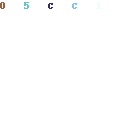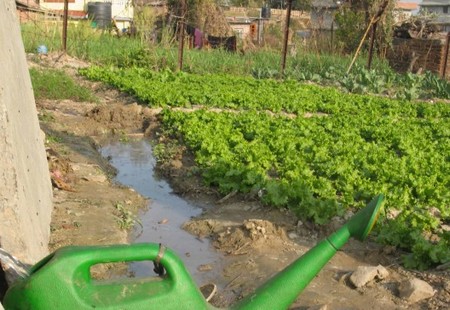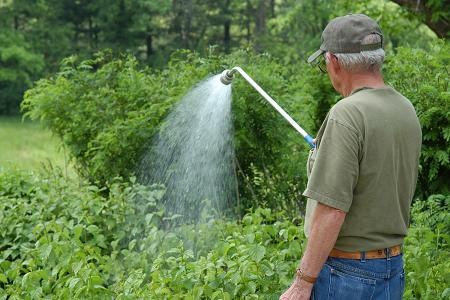Some vegetables can crop even in a dry summer, while others need water throughout their growing season or at key stages for worthwhile yields. To cut down on the work and waste, concentrate on watering those crops that will benefit most.
What needs watering?
Vegetables can be divided into three main groups according to how much water they need.
- Vegetables that show no real benefit from watering once established. Some may produce excessive leaves at the expense of edible roots if they are watered too often. Water only at the seedling or young plant stage.
- Vegetables that benefit from watering at a key stage in their growth, for example when they are producing fruits, pods or tubers. Watering before this will encourage only leafy growth.
- Vegetables that benefit from regular watering in dry weather to produce lush or succulent leaves or stems. Even these need a generous soaking only once a week rather than more frequent light sprinklings.
How much water?
After several weeks without rain, the soil surface will appear dry. However, before watering, dig a hole 13-15cm down. The chances are, particularly if you have used a mulch, that the soil lower down will feel damp and so will not need water. Soils that are dry 13-15cm down will need watering.
The amount of water needed for most vegetables in the second two groups is 22 litres per sq m once a week. To convert this to a length of row, divide one metre by the inter-row spacing for that crop – giving you the length of row to receive that quantity of water, e.g. lettuces with inter-row spacings of 30cm need 22 litres for every 3.3m length of row.
How to reduce watering
- Increase the water-holding ability of your soil either by adding organic matter as a mulch in spring or by making a trench the autumn before. In a drought, avoid digging the soil, as doing so will just dry it out further.
- Adding plastic sheet mulch for widely spaced crops such as sweetcorn will help to conserve moisture.
- Hoeing will keep the surface of the soil dry and prevent evaporation from deeper in the soil.
- Draw up a ridge of soil around widely spaced crops. This helps water run into the ground rather than off the surface.
- Use funnels (made from plastic drinks bottles with their bottoms cut off) buried in the ground to direct water to the roots of crops.
- All vegetables in containers need to be watered. Move the plants to lightly shaded positions during periods of drought. Grouping them together and fitting them with automatic watering systems will help reduce the work.
Watering options
Young plants and seedlings can be watered using a watering can with a detachable rose, with the rose fitted so that the water comes out as a fine spray. More mature crops can be watered without the rose. Direct a steady stream of water on to the soil, giving it time to soak in. The average watering can holds 10 litres.
Lay a leaky hose on the surface of the soil. Water seeps out of the sides. Leaky hoses are more efficient than sprinklers as the water is not scattered on foliage and in the air. They are flexible enough to be laid in various shapes, so are useful for small beds. It is easy to forget to turn them off, so consider using them with a water timer.
When you are growing a lot of plants in containers (or in a greenhouse) and are not around to water them regularly, automatic irrigation systems are useful. These can be used on the patio or in a greenhouse, and consist of a network of plastic tubing with small nozzles or drippers for each pot. They need to be set up and checked to ensure they are delivering the correct amount of water, and can be automated by using a watering computer fitted to the tap.
Categories
Advertisements
Recent Articles
 How to Understand Bed Sizes – A Small Guide
How to Understand Bed Sizes – A Small Guide How to Select Some Must Have Kitchen Accessories
How to Select Some Must Have Kitchen Accessories Best Way to Change a Car Tire
Best Way to Change a Car Tire Best Way to Write an Affirmation
Best Way to Write an Affirmation Best Way to Take Charge of Your Financial Life
Best Way to Take Charge of Your Financial Life Best Way to Survive a Party When You Don’t Know Anyone
Best Way to Survive a Party When You Don’t Know Anyone Best Way to Stop Self Sabotaging Yourself
Best Way to Stop Self Sabotaging Yourself Best Way to Start Journal Writing
Best Way to Start Journal Writing Best Way to Speak with a Powerful Voice
Best Way to Speak with a Powerful Voice Best Way to Simplify Your Life
Best Way to Simplify Your Life Best Way to Respond to a Put-Down
Best Way to Respond to a Put-Down Best Way to Reduce Acne Breakouts
Best Way to Reduce Acne Breakouts Best Way to Recover from Dining Disasters
Best Way to Recover from Dining Disasters Best Way to Quit Your Job Gracefully
Best Way to Quit Your Job Gracefully Best Way to Make Your Own Website
Best Way to Make Your Own Website




Leave a Reply